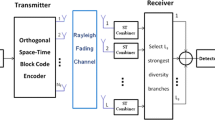Abstract
It is well known that the full rate and full diversity complex space-time block code (STBC) is not existed for four transmit antennas. In this letter, we propose a simple quasi-orthogonal space-time-frequency block code (QO-STFBC) scheme with four transmit antennas and n R receive antennas, where every two transmit antennas constitute one group and each group transmits signals over different subcarriers. The receiver can separate the received signals from each group via odd/even index FFT operation. After recombining the separated received signals with received antennas, an equivalent half rate orthogonal STFBC (O-STFBC) can be used for decoding. Thus, the full rate and full diversity are achieved at the transmitter and receiver, respectively. Simulation result shows that the proposed QO-STFBC scheme has better performance than the other schemes, in rate 2 layered Alamouti scheme is about 4 dB, full rate QO-STBC scheme is about 5 dB and half rate O-STBC scheme is about 7 dB at 10−3 BER for the transmission of 2 bits/s/Hz.
Similar content being viewed by others
References
Alamouti A. (1998) A simple transmit diversity scheme for wireless communications. IEEE Journal of Selected Areas in Communications 16: 1451–1458
Tarokh V., Jafarkhani H., Calderbank A. R. (1999) Space-time block codes from orthogonal designs. IEEE Transactions on Information Theory 45: 1456–1467
Jafarkhani H. (2001) A quasiorthogonal space time block encodes. IEEE Transactions on Communications 49: 1–4
Tirkkonen, O., Boariu, A., & Hottinen A. (2000). Minimal nonorthogonality rate 1 space-time block code for 3+ Tx antennas. In Proceedings of IEEE 6th international symposium on spread-spectrum techniques and applications (ISSSTA 2000), pp. 429–432.
Su W., Xia X. (2004) Signal constellations for quasi-orthogonal space-time block codes with full diversity. IEEE Transactions on Information Theory 50: 2331–2347
Bolcskei, H., & Paulraj, A. J. (2000). Space-frequency coded broadband OFDM systems. In Proceedings of IEEE wireless communications and networking conference (WCNC), Vol. 1, Chicago, IL, pp. 1–6.
Shao L., Roy S. (2005) Rate-one space-frequency block codes with maximum diversity for MIMO-OFDM. IEEE Transactions on Wireless Communications 4(4): 1674–1687
Liu, Z., Xin, Y., & Giannakis, G. B. (2002). Space-time-frequency coded OFDM with sub-carrier grouping and constellation precoding. In Proceedings of international conference on acoustics, speech and signal processing (ASSP), Vol. 3, Orlando, FL, pp. 2205–2208.
IEEE Standard for Local and Metropolitan Area Networks-Pt. (2009). 16: Air Interface for Broadband Wireless Access Systems, IEEE 802.16-2004.
Hou J., Lee M., Park J. (2003) Matrices analysis of quasi-orthogonal space-time block codes. IEEE Communications Letters 7(8): 385–387
Author information
Authors and Affiliations
Corresponding author
Additional information
This work was supported by 2011-02076, China, and R32-2012-000-2014-0, FR 2010-0020942, MEST 2012-002521, NRF, Korea.
Rights and permissions
About this article
Cite this article
Song, W., Balakannan, S.P. & Lee, M.H. A Simple Space-Time-Frequency Block Code Scheme for Four Transmit Antennas. Wireless Pers Commun 70, 1363–1372 (2013). https://doi.org/10.1007/s11277-012-0753-9
Published:
Issue Date:
DOI: https://doi.org/10.1007/s11277-012-0753-9




